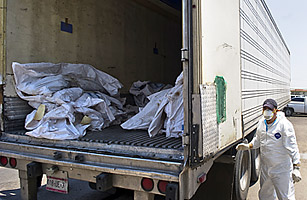
Mexican soldiers found a seventh mass grave in Durango, Mexico, this week, and its location was as unexpected as the six before it. TIME was one of the first media at the scene on Thursday, May 19, as forensic officials descended on a white stucco house in the upscale Jardines de Durango neighborhood to unearth presumed drug-cartel victims buried in the garden. Like the other grisly fosas, or narco-graves, uncovered in this northern desert city since last month — many of which were in middle-class backyards or near schools — the latest raised an unsettling question: How could residents and authorities not know something was terribly amiss at the house on Calle Petunias? “That’s the incredible part,” says Jorge Santiago, spokesman for Durango State Human Rights Commission.
Just as staggering is the number of bodies recovered so far in the Durango fosas: 218, a figure sure to rise with the newest discovery, and which surpasses the 183 exhumed since last month in the border state of Tamaulipas. Like the Tamaulipas corpses, many of those found in Durango are believed to be innocents as well as mafiosos. Either way, the sheer volume has human rights advocates looking at Mexico’s bloody drug war, which in four years has produced almost 40,000 gangland murders, through a more disturbing prism. To them it smacks of massacres witnessed in the Balkans in the 1990s, or Central America in the 1980s or South America in the 1970s — especially since corrupt Mexican police, like the 17 arrested for alleged involvement in the Tamaulipas slaughter, frequently take part. “It’s purely demoniacal,” says Javier Sicilia, a Mexican poet whose son, Juan Francisco Sicilia, 24, was murdered by narco-criminals this year. “It threatens our democracy.”
But after convincing his parents to offer DNA samples, she now waits to see if Rocha is one of those recently exhumed — to get closure but, just as important, to finally force a professional probe into his case. “It’s a pain, a daily anguish you can’t describe,” says Lpez, who lived with Rocha and planned to marry him. “These criminals don’t just take people, they take away whole futures.”
Residents like Lpez applaud the state and federal governments for giving them access to the DNA tests. But other families, many arriving at the attorney general’s office from nearby states, were more circumspect — worried that narco spies were scattered around the compound listening to their conversations. Durango officials fear it too. “We don’t know who’s friend or enemy here anymore,” one told TIME.
One hope, says Sicilia, who has turned his son’s killing into a surprisingly broad civic protest movement against Mexico’s violence, is that cases like Rocha’s will help the world realize “that the dead aren’t just figures and abstractions, narcos killing narcos, but potentially all of us.” And that in turn may put pressure on Mexican leaders to get more serious about judicial and police reform — which is the country’s only real solution to the narco-crisis, and which President Felipe Caldern has pushed along with his gutsy but ill-conceived military campaign against the cartels — and on U.S. leaders to reduce the drug consumption and smuggled guns that play such a large role in the tragedy south of the border.
As more decapitated bodies begin turning up in the city — including that of a local high-ranking prison official — the President has also sent in highly trained Marine units.
To symbolize the shared responsibility of the drug war, Sicilia’s Hasta la Madre!